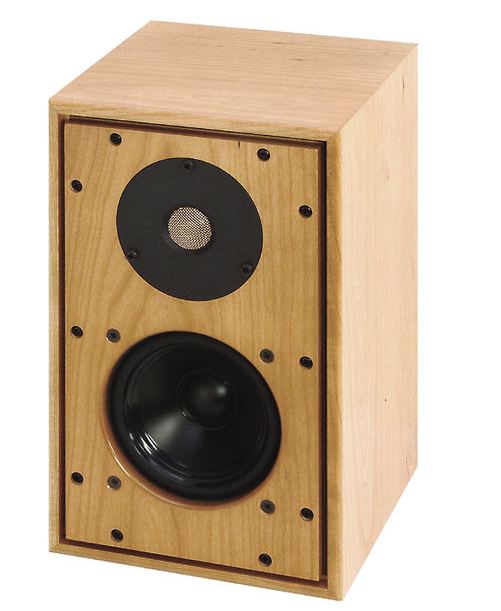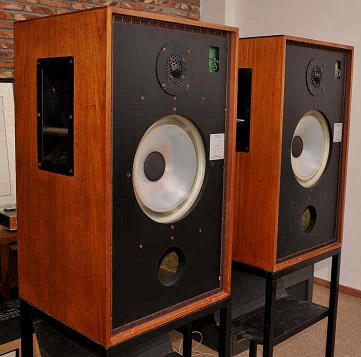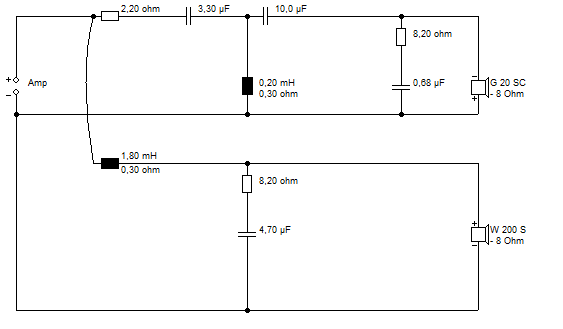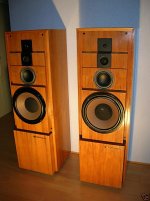Hi,
Does this make sense ? Harbeth 40.2 flagship speaker...
Diffraction horn like ? Or a way to deal with the cabinet corners ? Aesthetic ?
Does this make sense ? Harbeth 40.2 flagship speaker...
Diffraction horn like ? Or a way to deal with the cabinet corners ? Aesthetic ?
Attachments
Last edited:
There have been previous discussions on diyAudio, and you may find your answer there:
BBC rear-mounting drive units on baffles
Woofers mounted from the inside
BBC rear-mounting drive units on baffles
Woofers mounted from the inside
Hey, Hi Galu,
Thanks. I try to do my diy cabiney something like the Harbeth and/or the old Cabasse multi-layers front baffle... but want to know more not to sacrifice the sound with huge difraction... I have the router (brandnew Lidle ParkLife, lol) to flush mount... but I need to understand more than The Edge says about cubic cabinet sim and difraction...
Like how the 40.2 looks like...
Thanks. I try to do my diy cabiney something like the Harbeth and/or the old Cabasse multi-layers front baffle... but want to know more not to sacrifice the sound with huge difraction... I have the router (brandnew Lidle ParkLife, lol) to flush mount... but I need to understand more than The Edge says about cubic cabinet sim and difraction...
Like how the 40.2 looks like...
You'd really need to be inside the mind of Alan Shaw at Harbeth to know what he is doing.
But Harbeth are very BBC tradition, and recessed drivers are part of it.

You'd probably be using Power-flat Third Order Butterworth slopes, negative polarity on the tweeter and recessed drivers to get phase lined up or 90 degrees.
Most modelling programs can deal with acoustic centre adjustment. I am not sure I buy the current popular stepped baffle time aligned designs. There are other issues.
But Harbeth are very BBC tradition, and recessed drivers are part of it.
You'd probably be using Power-flat Third Order Butterworth slopes, negative polarity on the tweeter and recessed drivers to get phase lined up or 90 degrees.
Most modelling programs can deal with acoustic centre adjustment. I am not sure I buy the current popular stepped baffle time aligned designs. There are other issues.
Hi S7,
Thanks, I readed the J. Bagby paper about offset setting between two drivers in the filter soft design by merging the curves... a little dark yet... assymetrical XO seems good enough to deal with that but not sure I get it.
But yes, Alan Shaw's design is surprising with the tweeter in front of the others drivers... not intuitive for the noob I am!
Edit : for illustration; stepped baffle Cabasse loudspeakers.
Thanks, I readed the J. Bagby paper about offset setting between two drivers in the filter soft design by merging the curves... a little dark yet... assymetrical XO seems good enough to deal with that but not sure I get it.
But yes, Alan Shaw's design is surprising with the tweeter in front of the others drivers... not intuitive for the noob I am!
Edit : for illustration; stepped baffle Cabasse loudspeakers.
Attachments
Last edited:
Here's a hint: Alan comes from the BBC tradition where frequency / amplitude response dominates, rather than linear phase, which the majority of acoustic reasearch (see Toole et al) indicates is more or less inaudible with regular loudspeakers on music programme material. Short version: he couldn't give two hoots about time alignment.
could also be a simple as Allan not wanting to show the basket of the mid driver for what ever reason he might have. I can think of one and it's not time alignment.
So can I, but Volt (who speaking under correction do some of their OEM component work) don't normally produce lousy baskets.
Not talking about phase but ampliude only : does not this recess of the woof and mid create nasty diffractions; i.e. a pain for the wanted flat amplitude ?
Or at least 90° angle from a circle is nicer (or easier to correct in the filter) than 90° angle diffraction on a coffin cabinet shape ?
I am not buying the aethetic reason cause there is a front grill.
Or at least 90° angle from a circle is nicer (or easier to correct in the filter) than 90° angle diffraction on a coffin cabinet shape ?
I am not buying the aethetic reason cause there is a front grill.
I don't think Alan Shaw is being overly secretive.
Excellent factory tour here:
Harbeth Loudspeakers Factory Visit - YouTube
This looks like an old Rogers BBC broadcast monitor:

Rogers Loudspeakers › LS5/9
The recess also protects the cone from getting bashed.
I do this stuff myself:

Thing is, the more you recess the cone, the lower you can take the crossover point. Because negative polarity relies on a half-wavelength difference between the drivers. 3kHz is about 5cm.
Excellent factory tour here:
Harbeth Loudspeakers Factory Visit - YouTube
This looks like an old Rogers BBC broadcast monitor:
Rogers Loudspeakers › LS5/9
The recess also protects the cone from getting bashed.
I do this stuff myself:
Thing is, the more you recess the cone, the lower you can take the crossover point. Because negative polarity relies on a half-wavelength difference between the drivers. 3kHz is about 5cm.
You mean the tweeterwill see thefirst order boomer phase at 135 degreesinsread 90 so the phase roll off is nearer to 45 degrees?
Not talking about phase but ampliude only : does not this recess of the woof and mid create nasty diffractions; i.e. a pain for the wanted flat amplitude ?
Since the edge of the cavity is so close to the woofer cone, and it is rounded nicely, I doubt there will be much diffraction issues. Troels has shown that a stepped baffle up close to the tweeter has minimal effect (because it is so close), so a similar process is probably at work here.
In any case, whatever Harbeth is doing, it is working. We can speculate on why it works, but every Harbeth I ever heard sounded really nice. ... and they measure exceedingly well (see stereophile). Harbeth exemplifies the application of practical and expedient engineering. They get distortion down to a level where it is good enough. They build a cabinet that is just stiff enough and just damped enough to be good enough. They manage diffraction to the point where it is good enough. Then they focus relentlessly on frequency response, because that is what makes their speaker great.
It is a shame they are so pricey... being handcrafted in the U.K. and all that...
for the record Harbeth cabinets are made in China. The recessed woofer cone is not for nothing. It might be to better match dispersion of the woofer at crossover to the tweeter?
Best Regards Moray James
Best Regards Moray James
As far as I know it's 'just' to help with alignment around the crossover frequency[ies] & topologies Alan tends to target; they're usually lurking around 3rd / 4th order acoustic and with the offsets & typically inverted tweeter polarity it tends to line up. Fairly classic BBC-esque type approach.
Last edited:
You'd probably be using Power-flat Third Order Butterworth slopes, negative polarity on the tweeter and recessed drivers to get phase lined up or 90 degrees.
Most modelling programs can deal with acoustic centre adjustment. I am not sure I buy the current popular stepped baffle time aligned designs. There are other issues.
You often talk about 3rd order butt and i would like to try it, do you have values for sb or scan speak or seas drivers?
Hi HifiJim,
They are also pricey for us european, the average incomes are higher in USA than CE. Vandersteen for instance or Maggies are certainly better bangs for the hard earned monney and I have also no doubt your diy loudspeaker ceramic and time aligned is maybe better. FWIW, I chose the SB23NBAC-8 as midwoof after having hesitating with the CAC... CAC has a better VAS and parameters for a sealed but the NBAC a slighty better Le... So I took the last and planned something sealed but with a corck on a vent to make it on demand and also front and rear pannel à la Harbeth to modify the design... I'm a noob so it will maybe not to waste a single cabinet.
I read the paper of Troels about syepped baffle, indeed below 1" if I read well, the difraction is not a worry ! Though time aligned beginning of the voice coils between the ScanSpeak10F and the SB23NBAC if I chose stepped design is something like a little less 2", more 4 cm ! (without mic measurment so circa empirical).
Triple Yes Harbeth looks good with their 40.3 big monitor with the recessed mid and bass units.... a speaker that can lives in a living room without the front grill. Most doesn't like the stepped baffle but I always had a shaking heart for the old Cabasse design with angular recessed baffle (photographs above). ANd about the XO, I assume they don't play the text boo symetrical slope like Troels with his loved LR12... and if I have to choose on the paper (without knowing in the real world) I will assume a LR24 is more a pain for phase and transcient than a LR12... My problem is I want it passive, hence all the questions 😱.
Anyway the recessed drivers below the front baffle is cunter intuitiv. But measurments rule of course. Thanks to the members to remind me it's not that importanr here. I assume also a 8" driver not flushed on the front bafle is not a real (but aestheical) as well....
They are also pricey for us european, the average incomes are higher in USA than CE. Vandersteen for instance or Maggies are certainly better bangs for the hard earned monney and I have also no doubt your diy loudspeaker ceramic and time aligned is maybe better. FWIW, I chose the SB23NBAC-8 as midwoof after having hesitating with the CAC... CAC has a better VAS and parameters for a sealed but the NBAC a slighty better Le... So I took the last and planned something sealed but with a corck on a vent to make it on demand and also front and rear pannel à la Harbeth to modify the design... I'm a noob so it will maybe not to waste a single cabinet.
I read the paper of Troels about syepped baffle, indeed below 1" if I read well, the difraction is not a worry ! Though time aligned beginning of the voice coils between the ScanSpeak10F and the SB23NBAC if I chose stepped design is something like a little less 2", more 4 cm ! (without mic measurment so circa empirical).
Triple Yes Harbeth looks good with their 40.3 big monitor with the recessed mid and bass units.... a speaker that can lives in a living room without the front grill. Most doesn't like the stepped baffle but I always had a shaking heart for the old Cabasse design with angular recessed baffle (photographs above). ANd about the XO, I assume they don't play the text boo symetrical slope like Troels with his loved LR12... and if I have to choose on the paper (without knowing in the real world) I will assume a LR24 is more a pain for phase and transcient than a LR12... My problem is I want it passive, hence all the questions 😱.
Anyway the recessed drivers below the front baffle is cunter intuitiv. But measurments rule of course. Thanks to the members to remind me it's not that importanr here. I assume also a 8" driver not flushed on the front bafle is not a real (but aestheical) as well....
You'd really need to be inside the mind of Alan Shaw at Harbeth to know what he is doing.
Not really 😉, after gladly watching the factory tour video that you've posted about. Rather disappointed with the way Mr.Shaw described many other commercial loudspeaker designers as being less competent in respect to means used and dedication to develop a new design.
The truth was withheld for the sake of advertising.

Well
I have not owned a Harbeth, but a near relative, a Spendor Sp1/2R2. When i measured them (REW), they had a nice controlled frequency response, However, the directivity is a problem, crossing from a 8" driver to a tweeter at some 2.5 khz does not work well. This problem is documented for a Harbeth by Amir as well:
Harbeth Monitor 30 Speaker Review | Audio Science Review (ASR) Forum
I have not owned a Harbeth, but a near relative, a Spendor Sp1/2R2. When i measured them (REW), they had a nice controlled frequency response, However, the directivity is a problem, crossing from a 8" driver to a tweeter at some 2.5 khz does not work well. This problem is documented for a Harbeth by Amir as well:
Harbeth Monitor 30 Speaker Review | Audio Science Review (ASR) Forum
- Home
- Loudspeakers
- Multi-Way
- Haberth & recessed driver below the fron baffle


